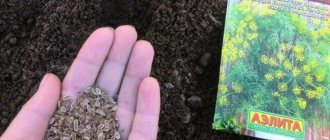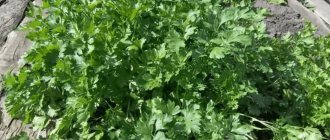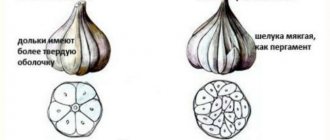Every gardener grows a pink root vegetable on his plot.
This is the first vegetable to ripen in the second half of May.
Typically, radishes are planted in April, when the soil is already warmed to 10 degrees.
And experienced farmers begin sowing before winter.
Is it possible to plant radishes before winter?
The only drawback to planting radishes before winter is the risk of seed death if the grower chooses the wrong time for sowing. However, this rarely happens, so let’s pay attention to the advantages of the method:
- Unlike spring sowing, winter sowing brings the harvest several weeks earlier. If you cover the crops with polyethylene in the spring, the ripening time will be reduced by a few more days.
- Seeds sown in autumn are much stronger and stronger than spring seedlings, as they are hardened in the ground and become resistant to many aggressive factors. Weak seeds die, and strong ones develop faster.
- Pre-winter sowing provides the seeds with the necessary moisture after the snow melts. Seeds also undergo a process of natural stratification. Spring crops may suffer from a lack of moisture due to the soil being overdried by the active sun.
- When sown in winter, radishes become resistant to diseases and pests and are not afraid of frost.
Having tried growing radishes in this way once, the vegetable grower will return to this method again, since this method has a lot of advantages.
What are winter radish crops?
The definition of what winter sowing is is contained in the very name of the technique - sowing before winter. It is the sowing of seeds in beds at a stable air temperature around 0 ° C and soil temperature +2 ... + 4 ° C that is called winter sowing. In different climatic zones, this moment occurs at different times, somewhere around the end of October, and in other places in November.
What varieties of radish are best to plant before winter?
The ideal radish variety for winter sowing has the following characteristics:
- not afraid of lack of light;
- frost-resistant;
- not prone to shooting.
Experienced gardeners prefer varieties such as Zhara, Zarya, and Rose-red.
Heat and Dawn ripen early. Root crops are harvested 15-25 days after germination. In addition, Zarya is distinguished by its high yield and resistance to light deficiency. The fruits have a pleasant taste, slightly spicy.
Pink-red radishes ripen at an average speed: vegetables begin to be harvested approximately 25-30 days after germination. This variety has a balanced taste, which is why it is very popular.
Planting radishes in the fall, before winter, is a risky business, but if you follow all the rules, then in early spring you can delight yourself with fresh vegetables.
Fighting cruciferous flea beetles
Nobody recommends using chemicals to control cruciferous flea beetles. We take the most terrible allergen, having previously put on protective gloves and a respirator - mustard and carefully, a very tiny pinch, sprinkle the rows of radishes. You can also use hot ground pepper, and you need a maximum of a teaspoon of mustard and pepper per square meter. After this, the crops need to be covered with a non-woven covering material, creating something like a greenhouse with a chemical attack on flea beetles.
An original way to protect radishes from cruciferous flea beetle:
About seven days before sowing radishes in the ground, it is necessary to sow watercress and mustard, and after another seven days, sow radishes in the rows of these crops. We act like Sherlock Holmes: the flea attacks the seedlings of competitors, we treat them with approved insecticides, strictly following the instructions on the packaging, and kill them, after which we just have to wait for the radishes to sprout and cut off the plants we don’t need that serve as bait. This method may well help, you can try it.
Cabbage fly
They say the cabbage fly is a terrible coward, and if you plant celery next to the garden bed (usually on its periphery), then it certainly will not come close to the areas of your radish.
Kila
As we already mentioned, acidic soils can be dangerous for radishes due to clubroot damage. If you are able to determine the pH of the soil or know that it is definitely acidic, then before sowing we recommend adding 150-200 g of chalk, 250-300 g of lime or 250-350 g of dolomite flour to the soil, of course, calculated per square meter and , ideally, for a year, but it is possible at least a month before sowing the radishes. Wood ash is a good soil deoxidizer; among other things, it contains up to 5% potassium and a fairly large composition of microelements, although in small quantities. Wood ash can be sprinkled in a millimeter layer directly into the base of the hole, and radish seeds can be sown on top.
Overgrown radish
How to properly plant radishes before winter
Before the onset of frost, the bed reserved for sowing is slightly loosened and fluffed up. The site is chosen on a slight elevation so that when the snow melts, the seeds do not flood.
Soil preparation
Autumn radishes grow well in garden beds where cucumbers, tomatoes, garlic, potatoes, peas and beans were previously cultivated. Undesirable predecessors: Cabbage, daikon, radish, horseradish and watercress are all members of cruciferous vegetables, as they accumulate common diseases and enemies that are transmitted through the soil.
The soil is prepared immediately after harvesting the previous crop. The soil is dug up, at the same time removing weeds and plant debris. Under digging for 1 sq. m add 25-35 g of superphosphate and ammonium nitrate, and also add 35 g of potassium sulfate - preferably in dissolved form.
On a note . If the soil on the site is severely depleted, then compost or humus is added to it (a bucket per 1 sq. m).
After digging and applying fertilizer, the soil is well loosened to a depth of 18-22 cm, this depends on the chosen litter.
Seed selection and preparation
First, the seeds are calibrated: placed in a saline solution for several minutes. The seeds that float up are thrown away, and those that sank to the bottom are taken out and dried. Next, the seeds are disinfected for about 20-30 minutes in a slightly pink solution of potassium permanganate, washed and dried again. Such preparation will allow you to grow large fruits and protect the crop from diseases. It is important that the seeds only swell, but do not germinate, otherwise they will die.
On a note. For autumn planting, prepare twice as many seeds as for spring sowing, since the planting material may be of poor quality, the seeds will not hatch and will die.
Planting pattern and depth
Grooves are made at a distance of 20 cm from each other . Then dry seeds are embedded in them to a depth of no more than 5-6 cm. Leave 3-5 cm between the seeds. The crops are sprinkled with dry soil.
The bed is covered with a layer of mulch, which will act as a protective cushion for the seeds. Mulching will protect the seedlings from temperature changes, spring thaws and frosts. Spruce branches or branches of shrubs are used as mulch. The bed is covered with a 20 cm layer. In winter, the beds are insulated with snow - this will help the seeds to successfully overwinter.
Important ! The place where radishes are sown should never be moistened, otherwise the seeds will hatch and die from frost.
Gardener's lunar calendar for March 2022
March is the traditional month for planting many seeds for seedlings, including according to the lunar calendar. In addition, other events can be held in the garden. The lunar sowing calendar for March 2022 recommends doing agricultural work in the following sequence:
- 1-2. You can plant radishes, carrots, and beets in the greenhouse. The moon at this time is in the constellation Capricorn, this has a positive effect on crops.
- 3-4. At this time, it is recommended to deal with already planted plants: weed, loosen the soil, hill up. You should not engage in planting and replanting, as well as apply fertilizers, since the Moon, which is in the barren sign of Aquarius, will have a negative impact on them.
- From 5 to 9. It is not advisable to disturb the plants. You can do preparatory work related to the ground. This is the period of the new moon, the Moon at this time successively passes through the constellations of Pisces and barren Aries.
- 10-12. During this period, it is recommended to plant tomato and cabbage seeds for seedlings. You can plant radishes and greens in a greenhouse. This is a favorable time to remove potatoes from winter storage for germination. The fertile constellation Taurus will have a beneficial effect on planting.
- 13-14. A favorable time for planting greens, as well as onions. You can do all the work related to soil cultivation. The Moon, located in the neutral constellation Gemini, will not have a noticeable effect on crops.
- 15-16. During this period, it is recommended to plant tomatoes, peppers, cucumbers, and cabbage seedlings. At this time, the finished seedlings can be planted in a heated greenhouse. At this time, the Earth's satellite is in the most fertile of all signs - Cancer. Therefore, even the most demanding and delicate crops planted during this period will sprout well and develop well.
- 17-18. It is not recommended to do any garden work at this time. The Moon is in the barren constellation Leo.
- From 19 to 20. It is recommended to engage in work related to the earth: loosening, weeding, hilling. There is no need to deal with seeds and seedlings these days. During this period, the moon is in the neutral constellation Virgo and will not have any significant effect on the plants.
- 21 March. Full moon, state of rest. No work is carried out at this time.
- You can plant early carrots and radishes in the greenhouse. The constellation Libra, in which the Earth's satellite is located at this time, is neutral and will not affect plants.
- 23-24. It is recommended to plant root crops and seedlings. You can plant seeds of peppers, cabbage, and tomatoes for seedlings. The moon at this time is in the fertile constellation Scorpio, which will have a good effect on the harvest.
- 25-27. A good time to plant spring garlic, radishes, and onions, if weather conditions permit. Parsley, celery, and dill planted during this period will produce good shoots. The Moon, located in the constellation neutral Sagittarius, will not have a noticeable impact on the crops.
- 28-29. During this period, you can plant potatoes, beets, onions, carrots, and radishes. Vegetables planted at this time will have the longest shelf life. The Earth's satellite is located in the fertile constellation Capricorn.
- 30-31. These days are not suitable for planting and working with plants. The infertile sign of Aquarius will negatively affect plants.
We invite you to familiarize yourself with Pine: the medicinal properties of needles and pine buds | Medicinal plants (herbalist)
on the influence of the lunar calendar on plantings:
Features of caring for such a planting
When warm weather arrives, the shelter is removed and the first shoots wait for the appearance. First of all, plants are provided with a comfortable “population density”. To do this, remove the weakest shoots so that the distance between the root crops is at least 5 cm.
Watering
Water depending on rainfall. Due to a lack of moisture, fruits become tough and will taste bitter, and due to its excess, vegetables become watery and tasteless. If there is no rain, water, but moderately. To prevent the formation of a crust on the top layer of soil from watering, the soil must be loosened.
For your information . Radishes are grown both in separate beds and in mixed plantings next to cucumbers, potatoes and cabbage.
Top dressing
If the soil is depleted, a herbal infusion diluted with water is used as a fertilizer. To prepare the fertilizer, fill the container a quarter full with water, then add recently collected herbs at the rate of 1 kg of plants per 10 liters of water and add 2 kg of dry chicken manure. The container is covered with a net.
The infusion is stirred every day and used only after the mixture stops fermenting, that is, when bubbles stop appearing. This takes 1-3 weeks. The resulting infusion is mixed with water in a 1:1 ratio. The product is watered at the roots of the plants.
On a note. If the soil is fertile, it is not necessary to apply fertilizers.
Diseases and pests
With the onset of warm weather, winter radishes are at risk from whiteweed, cruciferous flea beetles, clubroot, bacteriosis and blackleg.
An effective and safe way to control insects is to use ash and tobacco dust. If there are few pests, it is enough to lightly dust the tops with ash. Ash particles enter the respiratory tract of pests, causing their death.
In the future, to protect the plants, the radishes are sprinkled with lime and ash in a 1:1 ratio once a week. The procedure is carried out in dry weather and must be repeated after rains. A decoction of onion peels, which is used to water the seedlings, also helps well. The pungent odor repels insects.
In case of massive damage to plants, the following drugs are used:
- "Arrivo";
- "Kaiser";
- "Zolon";
- "Alfacin";
- "Tod."
Bordeaux mixture or lime solution is used against bacteriosis and clubroot: 100 g of lime is stirred in 2 liters of water. Blackleg is treated with a solution of 50 g of laundry soap and 1 tbsp. l. copper sulfate diluted in 10 liters of water.
Harvesting and recommendations
Before harvesting vegetables, the garden bed must be watered. Before morning harvesting, the soil is moistened in the evening, before daytime harvesting - 2-3 hours.
Recommendations for proper collection and storage of root vegetables:
- When harvesting, radishes are simply pulled by the tops.
- Before pulling the radish out of the ground, the soil from the top of the plant is lightly raked to determine the size of the root crop. All vegetables with a diameter of 2.5 cm or more are removed. If the root crop of the selected plant is still small, it is sprinkled with earth, allowing it to ripen.
- Since winter radishes ripen quickly, vegetables are checked as often as possible so as not to miss the right moment of collection.
- For further storage, vegetables are shaken off the ground, but not washed, the tops are cut off, leaving 3 cm. The fruits are placed in a plastic bag and sent to the refrigerator. This way, root crops will retain their marketability and taste for a long time.
Planting dates in autumn
Determining the timing of sowing seeds is the most crucial moment. The main thing for a gardener when planting radishes in open ground before winter is not to miss the time when the air temperature will be 0° C, the soil temperature will be from 2 to 4° C. For different climatic zones of Russia, this can be the end of October or November.
Here are the deadlines you can focus on:
- second ten days of October - in the central regions of Russia;
- early October - in the northern regions;
- late October or early November - in the south of the country.
If meteorologists promise warming, it is better to postpone sowing work. Otherwise, the radish seeds will begin to germinate, and the frosts that replace the warmth will destroy them. Experienced gardeners recommend sowing radishes when the top layer of soil freezes to about 3 cm.











